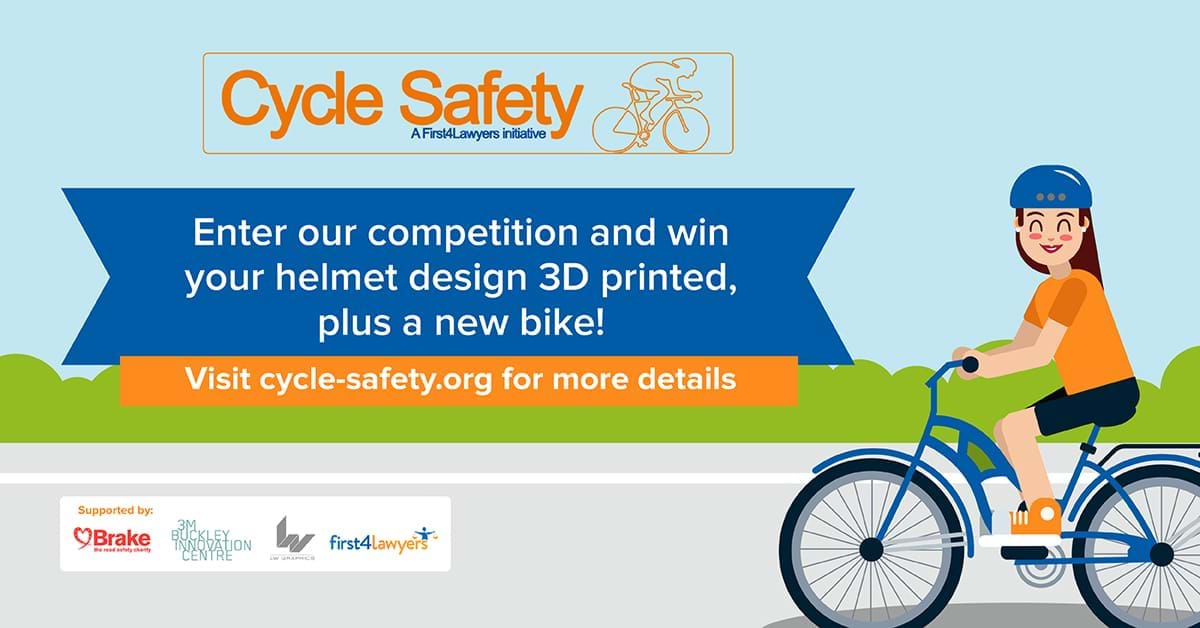Tips to stay safe when cycling (or around cyclists)

Did you know we are running a design a cycle safety helmet competition for primary schools at the moment, find all the details on the link below:
As a cyclist, being surrounded by much bigger and much more powerful vehicles such as cars and lorries can be daunting.
According to RoSPA, in 2016 there were 18,477 cycling injuries on UK roads, of which 3,499 were fatal or serious injuries. 81% of injuries were to male cyclists.
What can you do to reduce the chances of having an accident while you're on your bike?
Stay visible
As a cyclist you are often pretty much invisible to other road users, so it’s important to realise your vulnerability and act accordingly.
Make sure that you keep within view of cars wherever possible, especially at junctions and traffic lights. Avoid the blind spots of vehicles by using any advanced stop lines that are in place. These are a designated space for cyclists in front of cars at traffic lights. Alternatively, avoid drivers’ blind spots at junctions by stopping directly behind them rather than to the side - that way they can see you in their rear view mirror.
Bright clothing helps you be noticeable, particularly reflective clothing. Headlights and/or flashing lights can be used. In fact, it's illegal to ride of a public road between sunset and sunrise without lights and reflectors.
You should have a red light at the rear and a white light at the front, they must be fixed securely to your bike.
Protect yourself
Even if you're wearing all the right gear, accidents on cycles are always going to be a risk, because you are so vulnerable compared to motor vehicles.
Protective gear is something that's strongly recommended. A helmet may not look great, but it's there to protect you from serious head injuries.
Elbow and knee pads (or even knee guards which protect your shins too), gloves and body armour (especially if you are a mountain biker) are also a good idea to protect you if you should come off. Although it may seem costly to get fully kitted out, it’s not as costly as losing your life because you were unprotected in an accident.
Maintain your bike
Keeping your bike in top working order will not only keep you safe, but also legal!
Routine checks should include:
- Cleaning your lights and handlebars
- Checking chains, tyres and brakes. If your brakes are not efficient then you are breaking the law. Both brakes must be in full working order to keep you within the law.
- Consider getting your bike serviced - there are a number of retailers and independent bike sellers who offer bike servicing, which is recommended over attempting to fix the bike yourself if you are not confident or equipped to do so.
Ride the right way
It might seem obvious, but you shouldn't ride against the direction of traffic.
Although it's recommended for pedestrians and runners, as you're able to see what’s coming towards you, it is actually much more dangerous as a cyclist.
For example, drivers will not be expecting you to come from that direction when they pull out of junctions or driveways, so they are more likely to hit you. Plus it makes it almost impossible to turn left, so you’re only inconveniencing yourself by doing it.
If you can, take up the whole lane rather than hugging the curb. This stops cars from passing too closely, especially on narrower roads and lanes. It also stops the risk of people opening their car door and hitting you.
If you are blocking traffic by doing this either find a quieter route, or pull over and let vehicles pass, especially wider vehicles, as the Highway Code requires this.
Keep more to the right on roads with lots of side streets, parked cars or driveways to avoid any potential collisions (or car doors) and keep yourself visible.
Stay alert
If you’re commuting in a busy city in can be hard to find quiet streets to cycle down. It's important to keep aware at all times to avoid accidents due to a lack of concentration. Try to avoid listening to music or using your phone.
And always make sure to signal clearly so that drivers know what you are doing. They are less likely to try taking silly risks.
Drivers' responsibility
It's not all on cyclists to take responsibility - our recent survey found that many people believe drivers are the main problem.
Drivers need to pay attention and ensure the safety of cyclists, including:
- Allowing enough room when overtaking
- Looking out for cyclists in side and rear view mirriors, particularly if they could be cycling up the inside.
- Making sure you are clear of cyclists when opening your car door.
- Leaving enough space for them to access the advanced stop lines at traffic lights.
- Dip your deadlights when travelling towards cyclists at night.
With a little more attention and preparation, you could help reduce the number of cycling accidents on the UK's roads.


